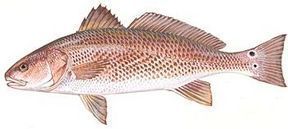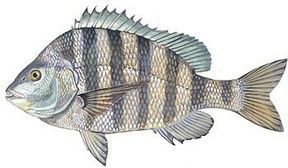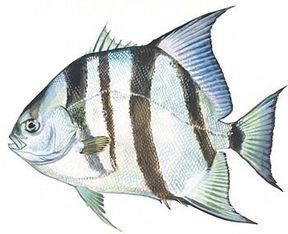

Charleston, SC Inshore Fishing Species
Headshaker Charters would like to highlight the various species of fish flourishing in the coastal waters near Charleston SC. Whether you are just out for a day of fishing in general, or you are looking to catch a particular species, Capt. Legare Leland has the experience and equipment to provide a memorable fishing experience.
Cast Your Line!
The coastal waters off of Charleston SC are teeming with a variety of fish, just waiting for you to cast your line. With a lifetime of experience in these waters, Capt. Leland is ready to provide your, your family, and your fishing buddies with a memorable angling experience. Contact Headshaker Charters today to learn more!

Red Drum
The Red Drum (Sciaenops ocellatus) is usually found in coastal waters. Also known as Channel Bass, Redfish, Spottail Bass or simply Reds, a three year-old red drum typically weighs six to eight pounds. The largest one on record weighed just over 94 pounds. Large red drums are called bull reds. Bull reds are merely mature red drums, and most people prefer not to eat them. Mature Red Drums spawn in near shorelines. Juvenile red drums typically inhabit bays and coastal marshes until they reach maturity, between 3 and 6 years of age. They will readily accept any bait but prefer Menhaden. The Red Drum is a relative of the Black Drum and the Atlantic Croaker, named for the croaking sound they make when they are not underwater. Like the speckled trout, the Red Drum is considered a big game fish.

Spotted Seatrout
The spotted seatrout (Cynoscion nebulosus) is a common estuary fish found in the southern United States. While most of these fish are caught on shallow, grassy flats, spotted seatrout reside in virtually any inshore waters, from the surf of outside islands to far up coastal rivers, where they often come for shelter during cold weather. Contrary to its name, the spotted seatrout is not a member of the trout family (Salmonidae), but of the drum family (Sciaenidae). It is also known as the speckled trout, or spotted weakfish.
These fish have large, prominent canine teeth. They have a dark back with gray or silvery sides marked with scattered ocellated black spots of varying sizes. The average size of the spotted seatrout is 1 to 2 lb, but in most areas fish up to 5 lb are fairly common. An ideal bait for the spotted seatrout is shrimp.
Spotted Seatrout are often found in shallow tidal creeks near flooded salt marshes, where it feeds mainly on shrimp and small fish. They are also known to congregate heavily over oyster reefs. The Spotted Seatrout, with its firm white meat, makes for excellent table fare.

Flounder
The Flounder, sometimes called the fluke, are flatfish that live in ocean waters like the Northern Atlantic, in waters along the east coast of the United States and Canada, and the Pacific Ocean, as well. The name "flounder" refers to several geographically and taxonomically distinct species. In Europe, the name flounder refers to Platichthys flesus, in the Western Atlantic there are the summer flounder Paralichthys dentatus, southern flounder Paralichthys lethostigma, and the winter flounder Pseudopleuronectes americanus, among other species. In Japan, the Japanese flounder Paralichthys olivaceus is common.
While flounders have both eyes situated on one side of the head, flukes are not born this way. Through a process of metamorphosis, one eye migrates to the other side of the body so that both eyes are situated on the upward-facing side of its body. After metamorphosis, flounder lie on one side on the ocean floor; either the left or right side might face upward depending on the species. Flounder sizes typically vary from five to fifteen inches, though they sometimes grow as large as three feet in length. Their breadth is about one-half of their length. Flounder are ambush predators and their feeding ground is the soft mud of the sea bottom, near bridge piles, docks, and other bottom encumbrances; they are sometimes found on bass grounds as well. Their diet consists mainly of fish spawn, crustaceans, polychaetes and small fish.

Sheepshead
The Sheepshead (Archosargus probatocephalus) is a marine fish that grows to 30 in (760 mm), but is more commonly found at 5 to 8 in. They are deep and compressed in body shape with 5 to 6 dark bars on the side of the body over a gray background. They have very sharp spines along the dorsal. Their diet consists of crustaceans such as clams, oysters, barnacles and fiddler crabs. They have a very hard mouth with several rows of stubby teeth that help it to crush their prey.
Although Sheepshead Bay, Brooklyn was named after the fish, they are very much a southern species. Today their range extends from the Mid-Atlantic to Texas. During the winters, many anglers in these states will head to the end of pier to fish for sheepshead. Favorite baits for these stealers include shrimp, sand fleas (mole crabs), and clams. Since sheepshead have a knack for stealing bait, so a very small hook is necessary. Locating sheepshead in a boat is not very difficult. Look for rocky bottoms or places with obstruction.
The sheepshead is great for eating. Because of its crustacean diet, its flesh is nice and sweet. It is best if filleted and pan-fried.

Black Drum
The Black Drum (Pogonias cromis) is a saltwater fish similar to its cousin, the Red Drum. Also known as Sea Drum, Saltwater Drum, Gray Drum, Drumfish, Striped Drum or Tambor, the Black Drum is the largest member of the drum family. Most are generally found in the 5 to 30 lb. Range. However, some specimens have been landed weighing in excess of 90lbs. The Black Drum is often black and/or gray in color with juvenile fish bearing distinctive dark stripes over a gray body.
The Black Drum’s teeth are rounded, and they have powerful jaws capable of crushing oysters and other shellfish.

Crevalle jack
Crevalle jack (Caranx hippos) is a fast saltwater fish that can be found in inland waters along the shoreline of the western Atlantic Ocean from Nova Scotia to Uruguay and the eastern Atlantic from Portugal to Angola. It has a large rounded head with large eyes and a dark silvery body that can show hints of blue-green to green-gold. They grow to more than three feet in length, though more commonly they are between one and two and a half feet long. This fish usually weighs between three and five pounds, but a 51-pound Crevalle Jack was taken off the coast of Florida.
Crevalle jacks can be poisonous to eat due to the threat of ciguatera poisoning, but they are prized as a game fish. Crevalle jacks spawn offshore from early March to early September. When young, they run in large schools, but become solitary as they get older. They are preyed upon by many surface-feeding carnivores, including finfish such as striped marlin, and seabirds. Crevalle jacks feed during the day and eat a variety of fish and invertebrates. Other names include common jack, black-tailed trevally, couvalli jack, black cavalli, yellow cavalli and a host of generic names such as horse mackerel and crevalle.

Ladyfish
Elopidae is a family of ray-finned fish containing the single genus Elops. The Ladyfish is a coastal dwelling fish found throughout tropical and sub-tropical regions. Spawning takes place at sea and the fish larvae migrate inland entering brackish waters. Their food is smaller fish and crustaceans (shrimp). Typically throughout the species the maximum size is 1 m and the maximum weight 10 kg. The body has a tapering spindle shape, and is oval in cross-section; being slightly laterally compressed, the eyes are large and partially covered with fatty (adipose) eyelids.
The larvae are leptocephalic - being highly compressed, ribbon-like and transparent. After initial growth they shrink and then metamorphose into the adult form.This family is fished but the body is bony and the fish may be ground down for fish meal.

Spanish Mackerel
The Spanish Mackerel (Scomberomorus maculates) exhibits a green back; its sides are silvery, marked with about three rows of round to elliptical orange spots. A lateral line gradually curves down from the upper end of the gill cover toward caudal peduncle. The first (spiny) dorsal fin is black at the front. Posterior membranes are white with a black edge. Its single row of cutting-edged teeth in each jaw are large, uniform, closely spaced and flattened from side to side.

Spadefish
The spadefish is a member of the family Ephippidae. There are about eight genera with a total of 20 species, mostly marine. The most well known species are probably those in the reef-dwelling genus Platax, the batfishes, which are kept as aquarium fish. They are spade-shaped, laterally compressed, and have very symmetrical triangular dorsal and anal fins. They are shiny silver with areas of yellow and vertical brown or black banding. The eyes are often located in one of the vertical bands as a method of camouflage. Scuba divers sometimes mistake them for angelfish, which are similar in shape but not closely related. Other genera in the family are characterized by long, trailing, pointed dorsal and anal fins.
Some spadefishes are popular sport fishing catches, such as the Atlantic spadefish (Chaetodipterus faber.) This is an attractive black and white zebra-striped fish common just offshore in the southeastern United States and Caribbean. They are an angler favorite because they put up a fight as they are reeled in. Spadefish are generally considered to be an over fished group, as most of the individuals caught are small and young and are nowhere near the maximum size recorded for their species.